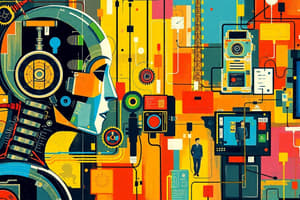Podcast
Questions and Answers
What is a significant consequence of automation in the legal industry?
What is a significant consequence of automation in the legal industry?
- Decline in employment for legal support jobs
- Increased reliance on human judgment over technology
- Reduction of data forces in the U.S. economy
- Improvement in efficiency by using software to sort documents (correct)
Which group is commonly associated with the belief that automation has caused economic issues post-Great Recession?
Which group is commonly associated with the belief that automation has caused economic issues post-Great Recession?
- Legal support staff
- Blue-collar workers
- White-collar professionals
- MIT professors Erik Brynjolfsson and Andrew McAfee (correct)
What is one of the main arguments presented regarding the effects of white-collar automation?
What is one of the main arguments presented regarding the effects of white-collar automation?
- It has eliminated the need for legal documentation.
- It has led to policies aimed at wealth redistribution. (correct)
- It reduces the need for all types of employment.
- It only benefits small businesses.
How has the employment landscape in the U.S. been affected by automation, according to the information provided?
How has the employment landscape in the U.S. been affected by automation, according to the information provided?
What is a key characteristic of automation as defined in the provided context?
What is a key characteristic of automation as defined in the provided context?
What is a primary argument regarding the employment impact of automation?
What is a primary argument regarding the employment impact of automation?
How has automation affected the legal profession specifically?
How has automation affected the legal profession specifically?
What does the paradox highlighted in the analysis suggest about job displacement due to automation?
What does the paradox highlighted in the analysis suggest about job displacement due to automation?
What evidence supports the claim that automation can lead to job growth?
What evidence supports the claim that automation can lead to job growth?
What is necessary for workers to benefit from automation, according to the analysis?
What is necessary for workers to benefit from automation, according to the analysis?
What is one significant effect of automation on employment as observed in historical contexts?
What is one significant effect of automation on employment as observed in historical contexts?
In the example provided, what was the outcome of desktop publishing systems implementation for typographers?
In the example provided, what was the outcome of desktop publishing systems implementation for typographers?
What effect does automation have on consumer prices according to the discussion?
What effect does automation have on consumer prices according to the discussion?
How did the rise of phone lines impact employment in telecommunications?
How did the rise of phone lines impact employment in telecommunications?
What is a historical reference used to illustrate the impact of automation on employment?
What is a historical reference used to illustrate the impact of automation on employment?
What is the net effect of computers on unemployment according to the analysis?
What is the net effect of computers on unemployment according to the analysis?
Which of the following is a necessary skill bank tellers will need to develop in the future?
Which of the following is a necessary skill bank tellers will need to develop in the future?
What long-term change is anticipated due to the growing use of artificial intelligence?
What long-term change is anticipated due to the growing use of artificial intelligence?
What does the analysis suggest about the relationship between job elimination and job creation?
What does the analysis suggest about the relationship between job elimination and job creation?
What is a near-term risk associated with automation in terms of existing jobs?
What is a near-term risk associated with automation in terms of existing jobs?
Which group is most significantly impacted by the rise of automation in the labor market?
Which group is most significantly impacted by the rise of automation in the labor market?
How do community colleges and trade groups propose to address the challenges posed by automation?
How do community colleges and trade groups propose to address the challenges posed by automation?
What role do certification programs play in the context of automation's impact on the labor force?
What role do certification programs play in the context of automation's impact on the labor force?
What is the ultimate goal of the strategies proposed to mitigate the effects of automation?
What is the ultimate goal of the strategies proposed to mitigate the effects of automation?
What is a major consequence of workers needing to learn new skills due to automation?
What is a major consequence of workers needing to learn new skills due to automation?
Flashcards are hidden until you start studying
Study Notes
The Automation Paradox
- Automation is not limited to blue-collar workers.
- Computers are automating tasks previously performed by professionals.
- Some experts attribute the slow economic recovery from the Great Recession and the decline of the middle class to automation.
- Others argue that white-collar automation is leading to persistent unemployment.
- The example of the legal industry highlights how automation is impacting professional jobs.
- Computers excel in tasks like sorting through legal documents, potentially displacing human workers.
- Employment numbers in the legal and support sectors have shown growth, indicating the impact of automation may not be solely negative.
- The job market is changing rapidly, suggesting the need for adaptation and new skills.
- The term "automation" refers to the automatic operation of equipment, processes, or systems.
- "Blue-collar" defines manual labor jobs, often demanding a specific work attire.
- The "Great Recession" was a period of significant economic decline from December 2007 to June 2009.
- "White-collar" refers to jobs that don't involve manual labor and often require formal attire.
Automation's Impact on Employment
- Automation has had a complex impact on employment, creating both new opportunities and challenges.
- While automation can displace workers in some tasks, it can also create new jobs and opportunities in other areas.
- The legal profession is an example of an industry where automation has led to increased accuracy and reduced costs in document discovery. Despite automation in legal discovery tasks, paralegal and lawyer employment has grown since the late 1990s.
- The author argues that the fear of mass job displacement due to automation is misplaced.
- Automation has led to job growth in other industries, such as banking (ATMs) and retail (barcode scanners).
- A chart shows that occupations with high computer use have experienced significantly faster growth than the overall labor market between 1980 and 2013, supporting the claim that automation can lead to job growth.
- Workers can adapt to the changing landscape of automation through training and learning new tools.
Automation's Impact on Employment
-
Automation can lead to job losses in some areas but create new opportunities in others.
-
Lower prices due to automation can increase demand and boost employment in related fields.
-
The rise of ATMs and legal document search engines illustrate how automation can create new jobs by increasing demand for related services.
-
Historical examples of automation, such as during the Industrial Revolution, have shown that automation can lead to significant increases in employment in new industries, like textiles and manufacturing.
-
Automation can also displace workers in specific jobs. For example, desktop publishing systems have reduced typographer jobs while increasing the demand for graphic designers.
-
Similarly, the increase in phone lines has reduced telephone operator jobs, but created new opportunities for receptionists.
-
The text concludes that automation doesn’t necessarily lead to job losses but rather shifts the types of jobs needed, replacing human workers with computers in non-computerized roles.
Graphic Design vs. Typographer Jobs
- There are 400,000 graphic design jobs and 300,000 typographer jobs.
Impact of Computers on Employment
- Computers have a mixed impact on employment, creating jobs in some areas while reducing them in others.
- The overall effect on unemployment is often neutral in the short term.
- The increasing use of artificial intelligence and software is changing the long-term outlook.
- Automation is expected to affect only 5% of existing jobs in the near term.
- The tasks performed within those jobs are likely to change significantly.
- Workers will need to adapt their skills to keep pace with these changes.
- For example, bank tellers may need to develop marketing skills in addition to their existing ones.
- The author argues that while computers may eliminate some jobs, they will also create new ones and reshape existing ones.
- This emphasizes the need for workers to adapt their skills to stay employed.
- The author believes that computers are not a major cause of long-term unemployment.
Automation's Impact on the Labor Force
- Automation presents a challenge for low-skilled workers, particularly those with less experience and lower pay.
- Workers may need to learn new skills on the job, which can be challenging.
- Community colleges and trade groups can collaborate to create work-study programs that combine classroom and practical training.
- Certification programs can help employers recognize the skills gained through experience.
- These strategies can help mitigate the negative impact of automation.
Question 1
- D. Devastation is the most accurate answer. The text emphasizes the significant negative social impact automation can have, particularly for low-skilled workers.
Question 2
- A. Consequences of automation is the best fit. The text explores the challenges and potential negative impacts automation can have on the workforce.
Studying That Suits You
Use AI to generate personalized quizzes and flashcards to suit your learning preferences.




